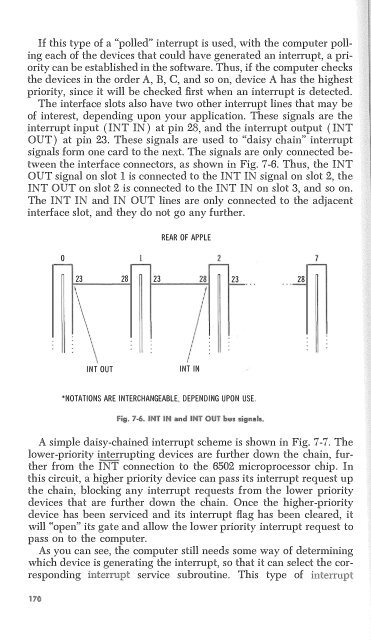You also want an ePaper? Increase the reach of your titles
YUMPU automatically turns print PDFs into web optimized ePapers that Google loves.
If this type of a "polled" interrupt is used, with the computer polling<br />
each of the devices that could have generated an interrupt, a priority<br />
can be established in the software. Thus, if the computer checks<br />
the devices in the order A, B, C, and so on, device A has the highest<br />
priority, since it will be checked first when an interrupt is detected.<br />
The interface slots also have two other interrupt lines that may be<br />
of interest, depending upon your application. These signals are the<br />
interrupt input (INT IN) at pin 28, and the interrupt output (INT<br />
OUT) at pin 23. These signals are used to "daisy chain" interrupt<br />
signals form one card to the next. The signals are only connected between<br />
the interface connectors, as shown in Fig. 7-6. Thus, the INT<br />
OUT signal on slot 1 is connected to the INT IN signal on slot 2, the<br />
INT OUT on slot 2 is connected to the INT IN on slot 3, and so on.<br />
The INT IN and IN OUT lines are only connected to the adjacent<br />
interface slot, and they do not go any further.<br />
REAR OF APPLE<br />
0<br />
23 28 23 23 28<br />
INT OUT<br />
INT IN<br />
*NOTATIONS ARE INTERCHANGEABLE, DEPENDING UPON USE.<br />
A simple daisy-chained interrupt scheme is shown in Fig. 7-7, The<br />
lower-priority interrupting devices are further down the chain, further<br />
from the INT connection to the 6502 microprocessor chip. In<br />
this circuit, a higher priority device can pass its interrupt request up<br />
the chain, blocking any interrupt requests from the lower priority<br />
devices that are further down the chain. Once the higher-priority<br />
device has been serviced and its interrupt flag has been cleared, it<br />
will "open" its gate and allow the lower priority interrupt request to<br />
pass on to the computeL<br />
As you can see, the computer still needs some way of determining<br />
which device is generating the interrupt, so that it can select the corresponding<br />
service subroutine. This type of

















